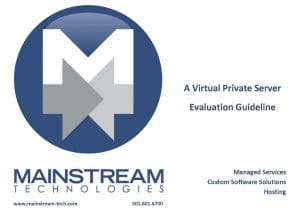 The most successful VPS implementations are the result of a detailed planning/testing process that reduces the chance for surprise.
The most successful VPS implementations are the result of a detailed planning/testing process that reduces the chance for surprise.
Compatibility, inter-operability, and performance concerns of using a Virtual Private Server (VPS) are justified and are why some IT administrators have been reluctant to adopt it. If there’s interest in the possibilities a VPS offers, it’s essential to create a very detailed blue print. Initially this blue print is used as an evaluation, and if the decision to proceed is made, it can be used to manage the migration process.
It must be stated that a VPS can add complexity to the architecture but this complexity can be offset by reduced staff workloads and the flexibility, scalability and elasticity a VPS offers.
Employing a VPS implies:
- The owner rents a VPS rather than owning the infrastructure. The provider is responsible for all asset design and procurement, monitoring, maintenance, support, licensing and up time.
- The owner eliminates a capital expense (new hardware) and replaces it with an operational expense.
- The focus shifts somewhat from managing technology to managing a contract (Service Level Agreement) with the provider.
DETAILED PLANNING IS ESSENTIAL:
It’s been our experience that the most successful VPS implementations are the result of a detailed planning/testing process.
It’s common to find that the transition/operational costs for migrating to a VPS architecture exceed the initial expectations. This is why we recommend creating a detailed migration plan which will reduce the chance for surprise. This plan will result in fully documenting the business needs, how they’re currently being met and what the expectations are for the new solution.
It will also be beneficial for predicting transition costs which will include resource requirements (i.e. internet bandwidth, processor requirements, staffing, etc), management overhead and the impact on support. These findings will also help determine the potential payback period for renting versus owning an infrastructure.
EXPECTATION EVALUATION
BUSINESS PROCESSES
- Existing processes
- Information created/used – what/who uses it now?
- How?
- When?
- Expected functionality of the new application
- Information created/used – what/who will use it?
- How?
- When?
- What are the manufacturer’s environment recommendations?
- Legacy apps to be used with the new application (Hybridization)
- How will they perform being connected to the new app thru the internet?
- What are the manufacturer’s recommendations?
- Other possible questions
- How will security be affected?
- What are the requirements (internet bandwidth, processor, disk, licensing issues)?
- What type of remote connectivity will work best?
- What are the fail over or DR options if there is a server/facility failure?
COSTS
Once the acquisition costs for the new application and architecture are known, a detailed review of the transition and operating costs (both hard and soft) should be documented.
Transition Costs
- Internal level of effort
- Management
- Planning
- Testing
- Roll out
- Provider level of effort
- Planning
- Testing
- Roll out
- Internet bandwidth increase
- Other?
Operational cost impact
- Operational cost increases
- Hardware
- Software licenses
- Application
- OS
- Communications
- Internet bandwidth requirements
- Service Level Agreement Management
- Operational cost reductions
- Support
- Maintenance
- Environmental
- Power
- Cooling
- Security
- Physical
- Asset Management
- Other
TESTING
Testing is imperative to assess how the new environment will perform. If at all possible, these tests should run in a manner that won’t affect users and their productivity. Testing will be instrumental for evaluating the new hybrid solution for:
- Compatibility,
- Inter-operability, and
- Performance
SERVICE LEVEL AGREEMENT
Once the application is in place the most critical success factor will be the provider’s service quality. Their Service Level Agreement (SLA) will formalize their commitment to customer service and how they’ll address requests and the escalation process. It will also include how they intend to address data backups and disaster recovery and may even offer performance guarantees.
All of these components are necessary to assure that the installation is stable and provides the best user experience possible.
CONCLUSION
If an organization is facing a hardware refresh or considering installing a new application, a VPS may be the right solution. It can be complex, but it also offers extensive scalability options and flexibility at very competitive rates.
Adoption of virtual private servers is growing because these advantages. They can help advance business strategies and goals, but it’s essential to perform the due diligence on the front end to assure that both the approach and the prospective provider are a good fit.
For more information on how virtual private servers can impact your business, give us a call @ 501.801.6700 or visit send us an email.





